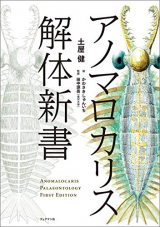2020/03/19 |
A Look at Science-Writer Ken Tsuchiya's Latest Book, "Anomalocaris Palaeontology" |
|---|

130 years.
Palaeontology, First Edition
- The unexpected history of reconstruction from the “abnormal shrimp”
- The Earth that Anomalocaris and its fellow creatures lived in, 500 million years ago
- Figures, dolls, and an anime… The secret behind Anomalocaris’ popularity
discovery of the “abnormal (anomalo) shrimp (caris),” when compared to the equally abnormal oceanic creatures of this period such as the five-eyed Opabinia and spiny-backed Halluciegnia, failed to draw a great deal of attention. Despite a subdued discovery, after many twists and turns, the Anomalocaris underwent a change, becoming the meter-long “king of the Cambrian Period.”
- A New Work Brought about through the Dedicated Work of Ken Tsuchiya, author of Riaru Saizu Koseibutu Zukan (An illustrated guide to the real sizes of extinct organisms).
Science-writer Ken Tsuchiya is known in Japan for his work Riaru Saizu Koseibutu Zukan (An Illustrated Guide to the Real Sizes of Extinct Organisms), a massively successful book that led to a boom in general reader interest in the topic of extinct organisms. With a particular talent in presenting palaeontology through the lens of a storyteller, this newest work represents the fruit of over a year’s worth of hard work.
- An AR Anomalocaris app for smartphones
The book comes with an AR app that replicates the movement of the Anomalocaris as it finds and consumes its prey. The model was designed to be as accurate to how Anomalocaris might have looked swimming as possible, based on the most recent scientific theories, with supervision from Professor Gengo Tanaka. The model’s size and direction can be freely changed, allowing for viewers to examine the movements in greater detail. Viewers can also take photos or videos.
For those Who Love the Anomalocaris
The reconstruction of the Anomalocaris began in 1892 with an essay by Joseph Frederick Whiteaves, and has gone through an eventful history over the last 122 years. Even Stephen Jay Gould, who describe the reconstruction of the Anomalocaris as “a tale of humor, error, struggle, frustration, and more error, culminating in an extraordinary resolution” could not have predicted the path its modern reconstruction would take.
As an author, having looked over so many changes throughout the Anomalocaris’ history, I cannot confidently claim the 2014 reconstruction to be the “definitive model.” I still believe there is the potential for new specimens, technology, or viewpoints to come along and update our present information, leading to a new chapter in this tale of startling surprises.
Extract from original text
Japan’s Award for Contributions to Palaeontology for his work as a science-writer in 2019. His recent works include Nihon no koseibutsu tachi (The extinct organisms of Japan), and Koseibutsu no shitataka na ikikata (The difficult lives of extinct organisms).
Osaka Prefecture in 1990. A creator who draws animals regardless of grouping, with an ability to express the exciting points of ecosystems. Graduated from Konan University’s Faculty of Law. Retired from trading company to work fulltime as an artist. On top of picture-books and art exhibitions, books he has directed illustrations and cover-art for include Futabasuzukiryū mou hitotsu no monogatari (Futabasaurus: Another story).
